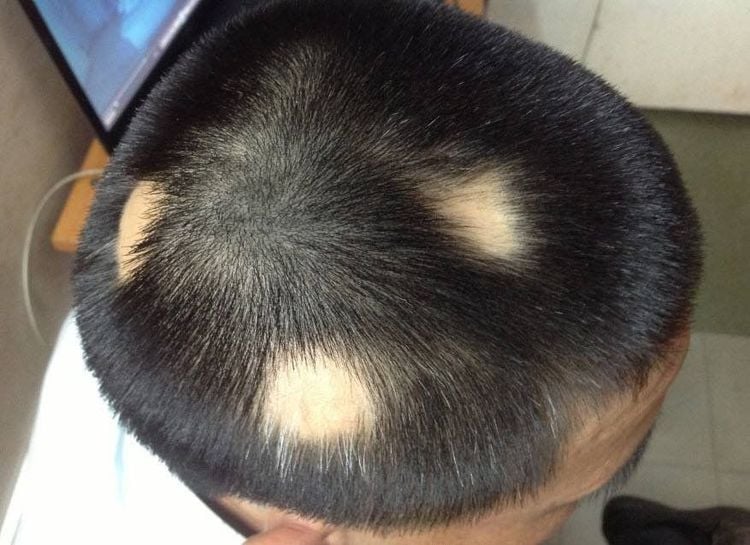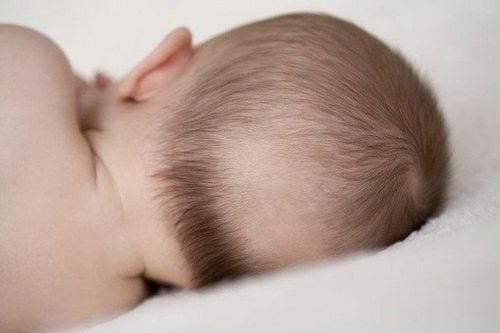This is an automatically translated article.
Alopecia areata is an autoimmune disease that can cause severe hair loss that is difficult to treat. This also makes patients feel less confident about their appearance as well as increases stress when facing illness. Alopecia areata can have many different causes. Identifying the underlying cause of the disease will help you choose the right treatment.
1. What is alopecia areata?
Alopecia areata is a condition in which hair falls out in small patches, making it difficult for the patient to notice. This hair loss usually develops when your immune system attacks the hair follicles and causes the hair to fall out.Sudden hair loss can occur on the scalp, eyelashes, eyebrows, facial hair and other parts of the body. It usually develops slowly and there is a risk of recurrence after many years of treatment.
In general, the amount of hair loss varies from person to person. Some people only have hair loss in a few spots on the scalp, but there are also people who have a lot of hair loss, even more serious, whole body hair loss.
There is currently no definitive treatment for alopecia areata. However, certain measures can help your hair grow back faster while preventing future hair loss.
2. Causes of hair loss in patches
Alopecia areata is an autoimmune condition, meaning your body's immune system mistakes healthy cells for foreign substances. Normally, the immune system is responsible for defending your body against "invaders" from the outside environment, such as bacteria and viruses. However, when there is alopecia areata, the immune system mistakenly attacks your hair follicles, causing the hair follicles to not function properly, thereby causing hair loss.
Alopecia areata is most common in people with a family history of other autoimmune diseases, such as type 1 diabetes or rheumatoid arthritis. This is also why scientists suspect that genetic factors may contribute to the development of alopecia areata.
In addition, researchers also suggest that certain factors in the environment may trigger alopecia areata in people with a genetic predisposition to it.

Bệnh tiểu đường thường xảy ra tình trạng rụng tóc từng mảng
3. Symptoms of alopecia areata
When alopecia areata, hair often falls out in small patches on the scalp. These patches are a few centimeters or less in size.
Hair loss can also occur in other parts of the face, such as eyelashes, eyebrows and beard. Some people experience hair loss in only a few places on the scalp, while others may have large patches of hair loss.
Alopecia areata can be easily noticed after you wash your hair, comb your hair or lie on a pillow. In general, this hair loss often has the following symptoms:
Appearance of small bald patches on the scalp or other parts of the body Patches of hair loss may grow large and develop into a bald patch Hair regrowth in one spot and elsewhere Hair loss in a short period of time Fingernails and toenails become red, brittle, and pitted feel a tingling or burning sensation before the hair in that area falls out.
In rare cases, excessive hair loss can be a sign of another type of hair loss, such as:
Alopecia totalis: The loss of all hair from the scalp. Alopecia areata: The loss of all hair on the body. The hair loss associated with alopecia areata is often unpredictable and appears to be a spontaneous condition. Hair can grow back at any time and then fall back. The degree of hair loss and regrowth is also different for each person.
4. Patchy hair loss in men
Alopecia areata can occur in both men and women, however the condition tends to affect more men, especially those with a family history of hair loss.
In general, men can experience hair loss on the scalp, face, chest and back. Compared with male pattern baldness, patchy hair loss often causes patchy and irregular hair loss.

Rụng tóc từng mảng thường xảy ra ở nam giới nhiều hơn
5. Patchy hair loss in women
Alopecia areata in women often occurs in areas of the scalp as well as eyebrows and eyelashes. Hair can fall out all at once or spread, causing more hair to fall out.
6. Patchy hair loss in children
Children are also another subject that can experience patchy hair loss. In fact, most people with this condition will experience hair loss for the first time before the age of 30.
Although several genetic factors are associated with alopecia areata in children, it is not always possible for parents with the condition to pass it on to their children.
In addition to hair loss, children can also develop nail and foot defects, such as pitting or nail damage. Adults can also experience these symptoms, but it's more common in children.
7. Prognosis of alopecia areata
The prognosis for alopecia areata is different for each person. On the other hand, this disease is difficult to predict.
Once you have this autoimmune condition, you may have to live with intermittent hair loss along with other related symptoms for life. However, there are also cases of hair loss only once.
In addition, the recovery process after alopecia areata is not the same for each person. Some people will see their hair grow back completely, but there are also people who not only will not grow back, but will lose more than before.
For conditions where hair loss is difficult to reverse, it can be related to a number of factors:
Early onset of the disease at a young age Excessive hair loss Altered nails Family history Having medical conditions other autoimmune conditions
8. How is alopecia areata diagnosed?
A doctor can diagnose alopecia areata simply by looking at the extent of hair loss or by examining several samples of the patient's hair under a microscope.
In addition, your doctor may also perform a scalp biopsy to rule out other conditions that cause hair loss, including tinea capitis. During the biopsy, a small portion of your scalp will be taken and analyzed in a laboratory. In addition, blood tests are also useful if other autoimmune conditions are suspected. A blood test will help your doctor detect the presence of one or more abnormal antibodies in your blood.
9. Treatment of alopecia areata
Although alopecia areata cannot be completely cured, it can be improved with some of the following treatments:
*Corticosteroids: These are anti-inflammatory drugs indicated for autoimmune conditions. immunity. They can be injected into the scalp or used as a pill, ointment, cream, or foam. However, the use of corticosteroids will take a long time to take effect.
*Using Minoxidil (Rogaine): This method is usually applied on the scalp. Some patients notice the effectiveness of the treatment after only 12 months, but there are also some users who are quite disappointed with it.
*Topical Immunotherapy: This treatment is used when your hair is falling out heavily or repeatedly. In this therapy, you will use chemicals that help create an allergic reaction, thereby stimulating hair regrowth. However, it can cause a rash, itchiness, and it often has to be repeated several times for new hair to regrow.
10. Home hair care for alopecia areata
In addition to using drugs, you can apply some other hair care methods to help improve the symptoms of alopecia areata. These measures usually include brushing your hair gently, not dyeing it, curling it, or tying it too tightly. In addition, you should also wear a wide-brimmed hat when going outside to protect your hair from the sun.
Managing stress is also an extremely important step in improving alopecia areata. Some studies suggest that excessive stress may be a trigger for the development of alopecia areata and telogen alopecia.
Please dial HOTLINE for more information or register for an appointment HERE. Download MyVinmec app to make appointments faster and to manage your bookings easily.
References: webmd.com, healthline.com













